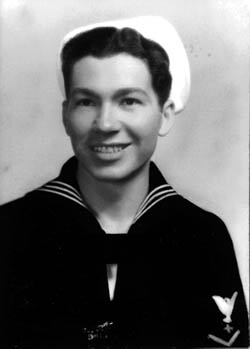Notes taken from an interview with Edward B. Caudle, a veteran of the Tarawa Invasion, by his son, Lieutenant Colonel Michael E. Caudle, US Army (ret.). on the occasion of Edward's 80th birthday, 18 March 2000, Lindale, Texas.

Edward B. Caudle, a native of Lindale, Texas (East Texas), enlisted in the U.S. Navy on 17 December 1941, ten short days after the Japanese bombing of Pearl Harbor. He reported to the San Diego US Navy Training Station where he received training as a Navy Corpsman. He received orders in mid-1942 to be detached to the 2nd Amphibious Tractor Battalion, 2nd Marine Division, and in December 1942 was deployed to New Zealand where he joined the Battalion as a Corpsman. His rank was that of Pharmacists' Mate First Class when the unit deployed for the invasion of Tarawa in the Gilbert Islands, Pacific ocean. After the bloody, but successful campaign, the Battalion survivors went to the Island of Hawaii where they regrouped and were re-equipped with men, weapons, and supplies. They established Camp Henry C. Drewes on the beach in honor of their commander who was killed at Tarawa. (Captain Lawrence assumed command of the Battalion after Drewes' death.) In 1944, the 2nd Amphibious Tractor Battalion was further deployed for the invasion of Saipan. Edward's ship became shipwrecked on a coral reef in the Marshall Islands, and he finally reached Saipan during the mopping-up operations. From there, he was reassigned to Brooklyn Navy Yard at Brooklyn, NY Receiving Ship. He reached the rank of Chief Pharmacists' Mate while there, and was discharged from the Navy in October 1945.
Mr. Caudle vividly recalls the early morning breakfast they were served prior to boarding Higgins boats for the invasion, and people getting sick from being tossed around for hours and from the anxiety of going into combat. He remembers going over the side of his LST and going down the nets to board the Higgins boats. He went in with the Headquarters and Service Company in the third assault wave. The Higgins boats circled at sea for several hours waiting for a beach head to be established. One of the Navy Corpsmen named Robert Smith, volunteered to drive one of the Amphibious Tractors to the beach. The tractor was hit by an enemy shell and all aboard were killed.
When his boat entered the lagoon, he and the men aboard disembarked and headed for a long pier that jutted out in to the lagoon. Enemy weapons fire was going over their heads. They had to hug the pier as close as they could because the footing dropped off sharply. As they slowly moved toward the beach they came to an opening in the pier where sea water rushed through, making crossing the gap treacherous; one had to kick hard to reach the other side of the gap. When he kicked-off to get across, he was swept out with the force of the water. A Marine behind him by the name of Yarborough, he thinks, reached out and grabbed him by his back pack and pushed him across the gap; he feels sure that his life was spared from drowning by the Marine's action. He never got a chance afterwards to find him and thank him.
The medical team consisting of a Doctor, Chief Pharmacist's Mate and several Corpsmen, reached the beach and set up a First Aid Station along a coconut log wall along the beach. There were Japanese soldiers actually inside the log wall who were shooting and killing Marines nearby until they were finally destroyed. Casualties were usually removed in the cover of darkness at night. Amphibious tractors and Higgins boats were used to transport the wounded back to hospital ships and LSTs offshore.
The medical Team was able to administer first aid to Marines, including stopping bleeding, setting bones, and giving blood plasma. Casualties were then either returned to action or sent back to offshore ships, depending on the severity of the wounds or injuries. It was chaotic on the beach and at the First Aid Station. Marines were often hit by enemy fire or sniper fire while waiting for treatment or during their treatment. When the fighting had subsided, he recalls one of the men on the team commenting that he hadn't taken a crap in three days. They didn't have time; they never really even thought about it until the fighting was over.

Officers of the Amphibious Tractor Battalion, 2nd Marine Division,
in New Zealand
prior to the Tarawa Invasion, November 1943.
Click the picture to enlarge.
First Row (l to r):
- CPT. (DR.) Stanbery
- CPT. Smithwick
- CPT. Lawrence (who took command of the Battalion after Maj. Drewes was killed)
- MAJ. Henry C. Drewes, Commander (KIA)
- CPT. Durand
- CPT. Royster (KIA)
Second row:
- LT. Ronck
- LT. Nygren
- LT. Handyside
- LT. Seigel
- LT. Eckart
- LT. Perry
Third Row:
- LT. Yousch
- LT. Little
- LT. Tenny
- LT. Housman
- LT. Musgrave
- Master Gunnery Sergeant King
- LT. Ward
Special thanks goes to the Caudle family for providing pictures and
information.
Thanks again Mike!
More information on amphibious tractors.
Send an Email
copyright 2000 T.O.T.W.
Created 22 April 2000 - Updated 28 May 2001

Return to Index
Return to Corpsman!
Return to Leathernecks